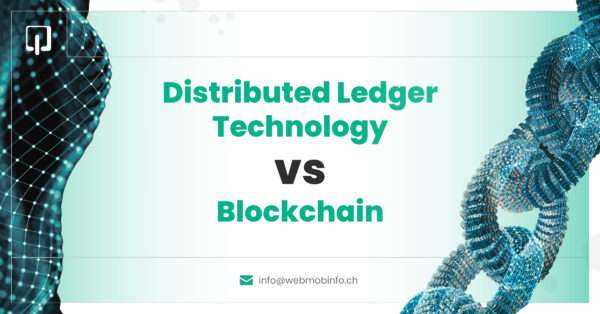It is common for people to need clarification about new technology in today’s digital environment. Since Distributed Ledger Technology (DLT) and Blockchain are often discussed together, it’s easy for those unfamiliar to confuse them. Some companies have even capitalized on this misunderstanding by using the term “Blockchain” in their branding, making it difficult to distinguish between them.
However, are DLT and Blockchain the same? They are not the same, even though they have some things in common. It is essential to comprehend their distinctions, particularly given their ongoing expansion and influence on diverse industries. Let us examine what makes these two different and consider some of their special real-world applications.
TABLE OF CONTENT
What is Blockchain?
The word “Blockchain” is always mentioned while discussing cryptocurrencies. Blockchain is sometimes confused with cryptocurrencies like Bitcoin, but that is not the whole story. Blockchain operates as a secure, shared database and is one type of Distributed Ledger Technology (DLT).
Blockchain can be compared to a highly secure digital ledger that records transactions. Every transaction is kept in a “block,” linked to the blocks before it builds a chain. It is called Blockchain for this reason. Cryptographic techniques are employed to guarantee the security and integrity of these transactions. As stated earlier, blockchain ensures that data integrity cannot be compromised.
Blockchain uses consensus mechanisms that require network participants to agree before new transactions can be added to the ledger. One popular method is the Proof-of-Work (PoW) mechanism seen in Bitcoin. This guarantees the accuracy of the documents, but it may also demand a large amount of processing power.
How Does Blockchain Work?
Blockchain is about data blocks. When new transactions take place, these blocks are generated. After that, the blocks are connected to form a chain of blocks, hence the term Blockchain. A block cannot be removed or altered once introduced. Blockchain’s immutability is one of its main advantages.
Blockchain networks are usually operated by several nodes or computers, which cooperate to validate the data within the blocks. Since the entire procedure is decentralized, no party has exclusive data control. Instead, consensus procedures are used to preserve the security and dependability of the network.
For example, you wish to send a friend some cryptocurrency. This transaction is part of a block that includes other transactions. The block is then added to the chain after being validated by the network. This guarantees the transaction’s validity and prevents data manipulation after it has been added.
What Is Distributed Ledger Technology (DLT)?
Though similar, Distributed Ledger Technology (DLT) and Blockchain differ. Although DLTs include Blockchains, not all DLTs are Blockchains. All that is essentially a distributed ledger is a database dispersed over multiple computers, or “nodes.”
Every node in a DLT system keeps a copy of the ledger on hand. When new or modified data is added, all nodes receive an update. Every node independently validates the data, guaranteeing accuracy and consistency throughout the network. Generally, a consensus algorithm is used for the verification process, although the exact method may differ depending on the kind of DLT.
One of DLT’s main features is its decentralization. Unlike traditional databases, distributed ledgers are not dependent on a single point of control, which is often kept in one place and run by a single entity. Because no single party controls or alters the data, DLT is considered more transparent and secure.
Types of Distributed Ledger Technology
DLT comes in different forms, depending on how the network is structured and who has access to it. Here are the main types:
Public DLT
Anyone can join a public DLT and participate in the network. Everyone can see every transaction, and anyone can assist in confirming the information. This includes blockchain technology, which powers cryptocurrencies like Bitcoin.
Private DLT
Only participants with permission can access a private DLT. Businesses that must communicate data among reliable partners frequently employ this kind of DLT. Consensus processes can be more effective because the participants are known than in open DLTs.
Consortium DLT
A consortium DLT is one in which several organizations collaboratively manage the ledger. Industries that need to work together on common data but still want to have some control over who joins the network frequently employ this strategy.
Blockchain vs. Distributed Ledger Technology: Key Differences
Now that we’ve defined Blockchain and DLT let’s examine their differences. While Blockchain is a form of DLT, several critical distinctions exist between the two.
1. Block Structure
One of the most noticeable distinctions is the block structure. Blockchain organizes data into blocks connected in a predetermined order. A block cannot be removed from the chain after it has been inserted. Because of this, Blockchain is highly secure and has a rigid data structure.
DLT, on the other hand, does not need block-level data storage. Data can be stored in a distributed ledger in various ways without requiring a sequential block structure, increasing DLT’s versatility in managing and storing data.
2. Immutability
One of blockchain’s main features is its immutability. Once data is added to the chain, it cannot be withdrawn or altered. Because of this, Blockchain in Fintech is perfect for use in financial transactions where data integrity is essential.
However, only some DLT systems are unchangeable. Although certain DLTs might provide comparable security levels, they might adhere to different stringent guidelines for data permanence. Because of this, DLT might be more flexible for some use cases, but it might also be less secure than Blockchain.
3. Consensus Mechanisms
Consensus procedures play a significant role in blockchain technology, which guarantees the accuracy of the data on the ledger. While one of the most well-known mechanisms is Proof-of-Work (PoW), which is energy-intensive, it is also utilized in Bitcoin. To solve some of the problems with Proof-of-Work (PoW), other consensus techniques have been created, such as Proof-of-Stake (PoS).
However, DLT doesn’t always require energy-intensive consensus techniques. Depending on the type of DLT, the verification procedure might be less energy-intensive and more efficient. As a result, DLT is more scalable and appropriate for uses in which efficiency and speed are crucial.
4. Token and Cryptocurrencies
Tokens and cryptocurrencies are integral to many Blockchain systems, providing incentives and enabling transactions. These tokens control system operations and provide incentives to network users. For instance, miners who validate transactions with Bitcoin receive rewards in the form of additional Bitcoins.
DLT, on the other hand, only sometimes requires tokens. Tokens are optional to all DLT systems, even though some may employ them for specific purposes. As a result, DLT may become more adaptable since it may be applied to a more significant number of scenarios without requiring a token-based economy.
Real-World Use Cases: Blockchain vs. Distributed Ledger Technology
Blockchain and Distributed Ledger Technology have found applications in various industries. Here are some real-world examples of how these technologies are being used.
1. Banking and Financial Services
One of the first industries to use Blockchain technology was finance. Numerous big banks and financial organizations are investigating blockchain to provide safe, transparent transactions. Digital identity verification and cross-border payment processing are two more activities that are made more efficient by distributed ledger technology.
Smart contracts, for instance, can be made with Blockchain and are self-executing contracts with the stipulations encoded directly into the code. By automating complicated financial operations, these contracts can decrease the need for intermediaries and boost productivity.
2. Insurance
The insurance sector is investigating blockchain and distributed ledger technology for identity verification and claim management. By adopting a decentralized ledger to produce an open, impenetrable claims record, insurers can decrease the danger of fraud.
For example, smart contracts on the blockchain can automate the claims process, guaranteeing prompt and equitable claims processing. Distributed ledger technology, on the other hand, enables insurers to confirm identities and monitor claims across several channels more efficiently by creating a shared database of client data.
3. Internet of Things (IoT)
Another area where Blockchain and DLT are having an impact is the Internet of Things (IoT). The demand for safe, open data sharing is rising as more devices are linked. Blockchain can provide decentralized security for IoT devices, allowing them to exchange data without relying on a central authority.
IBM, for instance, is developing an IoT and Blockchain integration to produce a decentralized device management solution. This system can check transactions, monitor device status, and guarantee data security.
4. Supply Chain Management
Supply chain management has found blockchain to be an invaluable tool. Blockchain can assist businesses in tracking the flow of goods from producer to customer by offering an open, unchangeable record of transactions. This is especially helpful in sectors where it is critical to guarantee product quality and authenticity, such as the food and pharmaceutical industries.
Walmart, for instance, tracks the source of food products in its supply chain using blockchain technology. By swiftly identifying the source of tainted food, Walmart can lower the possibility of extensive epidemics.
Future Outlook
We should anticipate further application cases in various industries as these technologies develop. Since its security and transparency are crucial, blockchain has made significant strides in the financial, supply chain, and healthcare industries. Due to its flexibility and reduced resource requirements, industries with essential efficiency and scalability will likely adopt distributed ledger technology.
In healthcare, Blockchain could enable patient-controlled, secure, decentralized medical records that ensure privacy while allowing access to authorized medical professionals. Conversely, Distributed Ledger Technology has the potential to expedite the development of novel medicines by streamlining the exchange of medical data between hospitals and research facilities.
Blockchain is already powering cryptocurrencies in the financial sector, but more established financial institutions might also embrace it for smart contracts and safe transactions. Because distributed ledger technology eliminates intermediaries and lowers prices, it has the potential to transform everything from international money transactions to loan processing completely.
If you are looking for professional blockchain development services for your next Distributed Ledger Technology (DLT) based project, then connect with our experts at info@webmobsoft.com
Nitin Gupta, the CEO of WebMob Software Solutions, is a visionary leader renowned for his innovative approaches to leveraging emerging technologies to transform businesses globally. Under Nitin's guidance, WebMob has evolved into a pioneer in fintech, catering to esteemed clients across Europe, APAC, and the Middle East. As a thought leader, he continues to drive WebMob towards new heights of success, cementing its reputation as an industry leader in the IT sector.

